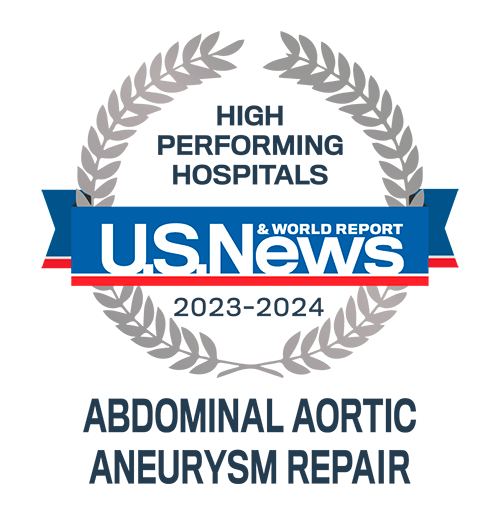Fenestrated Endovascular Aneurysm Repair (FEVAR)
What Is FEVAR?
Similar to endovascular aneurysm repair (EVAR), FEVAR is a minimally invasive procedure that allows surgeons to repair complex abdominal aortic aneurysms (aneurysms in the portion of the aorta that runs through the abdomen); thoracoabdominal aneurysms (aneurysms that extend through both the chest and abdomen); aortic dissections; and other diseases of the aorta. Small incisions are made in the groin and/or arms to preserve blood flow to the critical branch arteries to the kidneys and other organs.
Make an Appointment
Call 440-613-2462 today.
Schedule OnlineWho Might Need FEVAR?
FEVAR is offered as an option for patients who are not candidates for EVAR because they have an abdominal aortic aneurysm, thoracoabdominal aneurysm, aortic dissection or traumatic aortic injury located too close to the arteries that branch off to the kidneys, small bowel and liver.
Benefits of Fenestrated Endovascular Aneurysm Repair
FEVAR is a minimally invasive approach that offers patients many benefits over open surgery, including:
- Smaller incisions and less scarring
- Shorter hospital stays (typically one to two days)
- Quicker return to normal physical activity
- Fewer complications
- Reduced risk of a experiencing a heart attack or other life-threatening complications during the procedure.
Risks of Fenestrated Endovascular Aneurysm Repair
Although FEVAR has a high success rate and is generally safe, there is chance of complications, including:
- Blood clots
- Deep vein thrombosis (DVT)
- Endoleak (leaking of blood outside the stent graft and inside the aneurysm sac)
- Infection
- Kidney failure
- Bleeding
- Heart attack
Why Choose University Hospitals for FEVAR?
Unparalleled clinical expertise
Highest quality patient outcomes
Office visits and imaging coordinated on the same day
Quick, convenient access with sites across the region
Virtual appointment option for follow up care

As leaders in aortic aneurysm repair, University Hospitals Harrington Heart & Vascular Institute provides patients with the latest minimally invasive options available. UH Harrington Heart & Vascular Institute is one of the few specialized centers in the country that offers FEVAR.
UH earned a “high performance” rating – the highest rating possible – for abdominal aortic aneurysm repair in the U.S. News & World Report 2023 – 2024 “Best Hospitals” survey, which evaluated data from more than 4,500 hospitals throughout the country.
What Happens During a FEVAR Procedure?
FEVAR stent grafts are designed with fenestrations (holes) that line up with the arteries branching off the aorta to allow blood to flow to the kidneys, small bowel and liver. The fenestrations in the stent graft are customized for each patient based on their specific anatomy.
During the FEVAR procedure:
- You will receive general, regional or local anesthesia with sedation.
- If needed, a spinal drain is placed in your back to decrease spinal cord pressure.
- The surgeon makes small incisions in the inner parts of both legs to access your femoral arteries and catheters (thin tubes) are inserted.
- Using a special type of X-ray imaging called fluoroscopy, the surgeon guides one catheter to the damaged section of your aorta. This catheter contains the endograft.
- The surgeon positions and attaches the endograft inside the damaged part of the aorta.
- With the endograft in place, the surgeon guides catheters to place additional smaller endografts.
- Once the smaller endografts are placed, the catheters are removed.
What Happens After a FEVAR Procedure?
The FEVAR procedure usually takes only a few hours. After your procedure, you will stay in the intensive care unit (ICU), typically for a day or two. If you have a spinal drain, you will be asked to lie flat in bed until the spinal drain can be removed – usually 24 to 48 hours after the procedure. When you are ready to leave the ICU, you will be moved to a medical-surgical unit to complete your recovery while being monitored.
Once you are able to walk and tolerate a normal diet, you will be allowed to leave the hospital. A typical hospital stay after FEVAR lasts from three to seven days. Some patients may require a short stay in a rehabilitation facility to help them regain their strength.
The small incisions in your thighs will heal within one to two weeks of your procedure. You may require follow-up imaging within a week of the procedure to check that your endograft is working properly.


